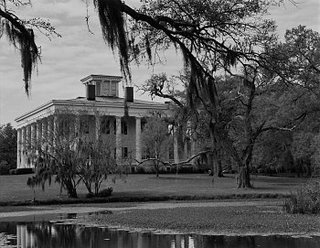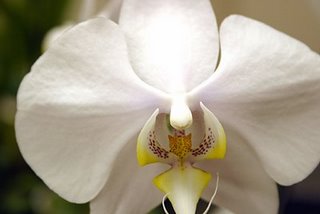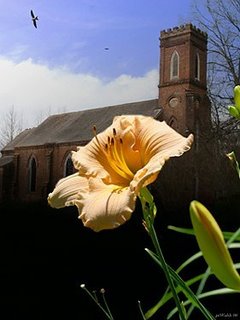PHOTOGRAPHERS’ PARADISE: PICTURE-PERFECT
ST. FRANCISVILLE, LOUISIANA

by Anne Butler
Fanning The Flame: that’s what one springtime photographic workshop in the St. Francisville area is entitled, and the entire region is so rich in artistic opportunities that it does indeed fuel the creative passions for photographers and artists of every stripe. Since the early 1820’s when artist-naturalist John James Audubon painted a large number of his famous Birds of America studies in the area, this lush little corner of Louisiana’s Plantation Country has proven irresistible to creative spirits due to its unspoiled landscapes, amazing architecture, plentiful wildlife and just plain picturesqueness. There are several resident photographers whose works may be purchased in the West Feliciana Historical Society’s museum and tourist information center in downtown St. Francisville. Pat Walsh with his wife owns and operates the St. Francisville Inn, and the two of them have been the inspiration behind many of the special events like the Audubon Birdfest each spring offering guided field trips into the more remote reaches of the parish for unsurpassed birding and photographing. A creative soul who is an accomplished chef and a whiz on the computer, Walsh has lately become enthused with photography, combining his talents by manipulating his architectural and nature photos on the computer to create real works of art. At both the St. Francisville Inn and the tourist center, visitors can purchase for extremely reasonable prices his prints of area plantations and landscapes. Another local photographer, Yolanda D’Aquilla, wife of St. Francisville’s mayor, offers for sale lovely black and white studies of some area scenes as well. In addition, Backwoods Art Gallery often exhibits works by Carin Carlson, St. Francisville artist whose incredible colorful close-ups of orchids showcase her skills as both painter and photographer.

end of March, the Fanning The Flame workshop attracts photographers from across the country for a week-long session led by enormously talented impressionist artist Darrell Chitty, two-time Louisiana Photographer of the Year, and Arthur Rainville, called “the Poet Laureate of Photography,” in an inspiring experience offering live costumed models, historic plantations, hands-on assistance with the computer program Corel Painter, an in-depth study of the artistic techniques of Old Masters like Monet and Sargent, creativity sessions and marketing advice. Information is available from Darrell Chitty at 318-741-1141. But it isn’t necessary to be a professional photogapher to find inspiration for sensational shots in St. Francisville, and March is the perfect time to do it. The annual Audubon Pilgrimage the third weekend of the month offers everything a photogapher could possibly dream of: lovely ladies and dashing gents authentically garbed in 1820’s costumes, antebellum gardens abloom with colorful azaleas and camellias, doors flung wide for visits to historic private plantation homes like Wakefield and Rosale and Catalpa, demonstrations of old-time skills at the rustic Rural Homestead, evening entertainments and ghostly graveyard tableaux. Information is available by telephone at 225-635-4224 or online at AudubonPilgrimage.info.
But quiet little St. Francisville is a year-round tourist destination, its peaceful thoroughfares shaded by ancient live oaks, the glorious galleries of its Victorian homes dripping with gingerbread, melodic hymns wafting through the stained glass windows of its historic churches, its main street still the viable center of life with small shops and restaurants filling restored structures. The entire downtown area, once the cultural and commercial center of the surrounding plantation country, is a National Register Historic District attesting to its architectural and historical significance. The photographic possibilities in town are endless, and within a few miles are half a dozen of Louisiana's most interesting plantations, each representing a different period of life in this unique corner of the state. Surrounding the area are the Tunica Hills, one of the most biologically diverse wilderness areas in the South, with steep hills and deep cool hollows supporting an enormous variety of flora and fauna, some seen nowhere else in Louisiana. It’s enough to drive a photographer batty!
The earliest plantations…The Cottage, Butler Greenwood and The Myrtles…all are similar in style, unpretentious raised cottages typical of the first-generation structures dating from the 1790's, when the first valiant efforts were made to tame the virgin woodlands and till the rich river bottomlands into vast fields of indigo and cotton, prospering sufficiently that the planters along the Great River Road from New Orleans to Natchez comprised a large percentage of America's mid-1800’s millionaires. The houses they built reflected their status. By the time the second and third generations of these plantation families built homes in English Louisiana in the 1830's, they had prospered sufficiently to afford grand Greek Revival structures like Rosedown and Greenwood, much more formal and elaborate than the first-generation houses. Non-typical Oakley Plantation, completed in the early 1800's, shows West Indies influence with jalousied galleries connected by exterior stairs, and it was the need of a tutor for the daughter of the family here that brought Audubon to the plantation in pursuit of his dream of painting all the birds of the young country America. Photographers and other visitors can tour these plantation homes and gardens daily, finding a wealth of photographic opportunities at each. Guests can even stay overnight in a number of them, and there are other fine B&Bs in the area as well, both historic townhouses in St. Francisville and golf resorts and lakeside properties in the surrounding countryside. After touring the plantations, photogaphers will want to spend some time in the scenic unspoiled wilderness of the Tunica Hills, a rugged region around St. Francisville that has long attracted enthusiastic hikers, bikers, birders, nature photographers, horseback riders and hunters. Ranging from St. Francisville northwest along the Mississippi River on north into Tennessee, these are actually foothills of the Appalachians, loessial ridges created by dust storms of the Glacier period which swept in from the western plains carrying powdery fertile soil to form vertical cliffs up to 90 feet high resting on the sand-clay bottom of an ancient sea bed.

With habitat areas ranging from the hilly bluffs and steep shady ravines of the uplands to the swampy river bottomlands and hardwood forests, bird photogaphers find the area still harbors the same rich abundance of birdlife that so inspired Audubon in the 1820's. Cat Island National Wildlife Refuge is one of the largest tracts of virgin wetland forest along the Mississippi River not protected by levees from cyclical flooding. Sometimes inundated by 15 to 20 feet of water in the spring, Cat Island supports huge populations of wintering waterfowl, as well as the world's largest bald cypress tree, believed to be 800 to 1500 years old and 83 feet tall. One of the most enjoyable ways to take in the scenery of the Tunica Hills region is on horseback, and Cross Creek Stables offers gaited horses for three-hour morning or afternoon rides along the sunken roadbed of the historic Old Tunica Road or on trails in the wildlife management area. For photographers, St. Francisville and the surrounding plantation hill country provides prime possibilities…architectural studies, portraiture, nature shots, landscapes. Each season of the year presents unique perspectives, and Louisiana’s changeable weather also provides inspiration for photographers…the morning mist rising from the river, the fog-shrouded Victorian headstones of the historic cemeteries, the rays of sunlight piercing the canopy of overhanging live oaks hung with Spanish moss, the pouring rain seen through a lace-curtained window, the deepening twilight as the barn swallows circle and shadows fall. The St. Francisville area abounds in scenes and settings and seasons guaranteed to fan the flame of creative passion in every photographer, regardless of level of skill. St. Francisville is located on US Highway 61 on the Mississippi River between Baton Rouge, LA, and Natchez, MS. For online coverage of tourist facilities, attractions and events in the St. Francisville area, see StFrancisville.us, StFrancisville.net or StFrancisvilleOvernight.com, or telephone (225) 635-4224 or 635-3873. For high resolution photographs in this article, please email pat@bluegoosemedia.com
Photo #1 - Greenwood Plantation by Yolanda D’AquillaThe
Photo #2 - Moth Orchid by Carin Carlson
Photo #3 - St. Mary's Children by Pat Walsh